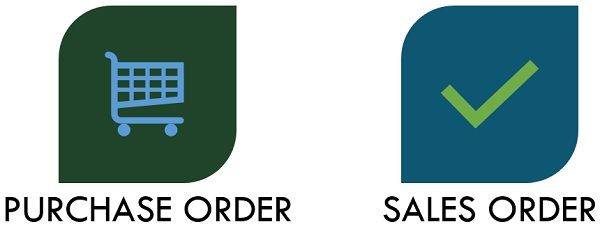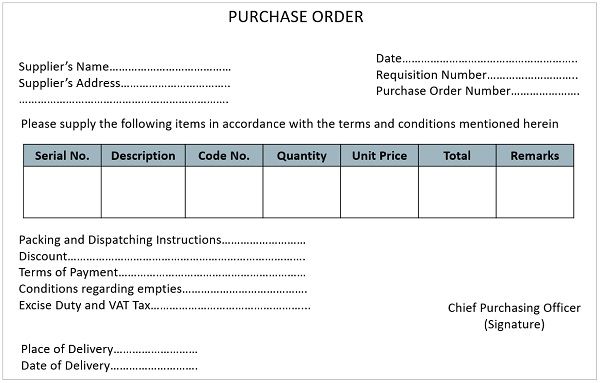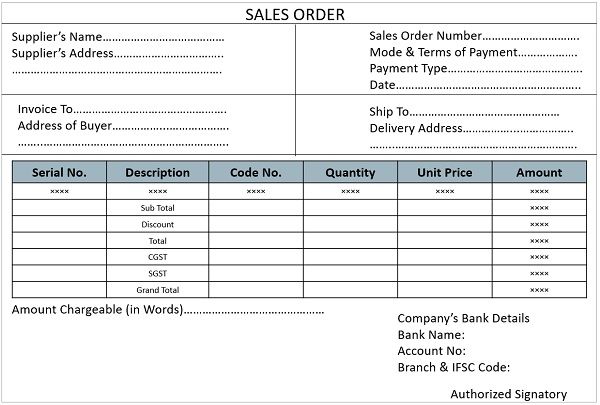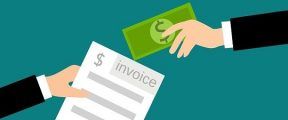 A Purchase Order is simply an order raised by the organization, which contains information related to the product or the number of products that the organization wants to purchase from a supplier. On the Contrary, a Sales Order implies an order generated by the firm and delivered to its customer that acts as a confirmation document regarding the supply of the specified quantity of the goods or services, at a specified time, and agreed upon terms and conditions.
A Purchase Order is simply an order raised by the organization, which contains information related to the product or the number of products that the organization wants to purchase from a supplier. On the Contrary, a Sales Order implies an order generated by the firm and delivered to its customer that acts as a confirmation document regarding the supply of the specified quantity of the goods or services, at a specified time, and agreed upon terms and conditions.
Basically, the purchase order conveys the list of items that the company would like to buy, based on the negotiated terms. Conversely, a sales order outlines the purchase order number, against which the sales order is issued, along with other information mentioned in the purchase order.
This post will help you understand the difference between purchase order and sales order, along with their importance in the field of business.
Content: Purchase Order Vs Sales Order
Comparison Chart
| Basis for Comparison | Purchase Order | Sales Order |
|---|---|---|
| Meaning | Purchase Order is a written commercial document that authorizes a supplier to supply the stated materials, at the agreed terms and conditions. | Sales Order is a confirmation document that is issued to the buyer by the seller, prior to the delivery of the specified goods or services. |
| Who prepares it? | Prepared by the buyer and is sent to the supplier. | Issued by the supplier to its buyer before delivery. |
| Effect of acceptance | Creates a contract between the buyer and supplier. | It approves the sale. |
| Document | Internal Document | External Document |
| Signifies | Intention to purchase certain goods and services from the seller. | Agreement to sell certain goods and services to the buyer. |
| When it is generated? | On the acceptance of the seller's offer, quotation, or proposal. | On receiving the purchase order. |
| Objective | To authorize sale | To confirm sale |
Definition of Purchase Order
Purchase Order indicates an official authorization of the buyer’s intent in the form of a written document prepared by the company’s purchase department, which authorizes the supplier to provide the stated quantity of materials of specified quality at the agreed-upon terms and price.
On the selection of the supplier from the list of available registered vendors, the purchasing department passes an order of materials and so preparation of the purchase order takes place. Purchase Order needs to be prepared carefully as it constitutes a legal contract between the contracting parties, i.e. the buyer and supplier. Hence, only selected responsible officials are authorized to sign the purchase order.
Note:
- The selection of the supplier is based on a number of factors i.e. price, quality, reliability, credit terms, and so forth.
- The supplier organization receives purchase orders either through customers i.e. the buying organization itself or through channel partners like distributors.
When the order is placed, the supplier is obligated to supply the materials, stores, etc based on the terms and conditions specified in the order itself. Additionally, the purchaser is also bound to accept the delivery of the goods supplied and pay for the materials, which are agreed upon.
Copies of Purchase Order
Purchase Order is raised in five copies, which is distributed to:
- The original copy is sent to the supplier of the goods.
- The second copy is kept by the purchasing department
- The third copy is issued to the goods receiving department which acts as a prior intimation to expect the materials.
- The fourth copy is handed over to the cost accounting department or accounts department for recording the entry in the ordered column of the concerned store’s ledger account.
- The final copy is issued to the initiating department requisitioning the material as an indication of the order and expected date of receipt of materials.
In the end, follow-up of purchase orders is taken, to make certain the timely delivery. Moreover, at the time of placement of the order, the purchasing department of the organization needs to ensure that the amount of the order, is not in excess of the purchase budget or the limit specified in this regard. Further, if the amount exceeds the limit specified, approval of the finance department has to be obtained first.
Purpose of Purchase Order
- Purchase Order (PO) serves as proof of the legal contract between the buyer and seller, that binds both the parties.
- It authorizes the supplier to deliver the specified material.
- It also authorizes the goods receiving department to accept the delivery of the materials which are ordered.
- It also authorizes the accounts department to accept the invoice from the concerned supplier, regarding payment of the delivery.
What is Purchase Order Form (POF)?
Purchase Order Form is a form used by the purchasing department to order specified supplies and materials, from the supplier. It depends on the specifications mentioned in the purchase requisition form, which bears the signature of the procurement manager. Purchase Order Form includes:
- Name and Address of the purchasing firm.
- Name and Address of the supplier.
- Date of Order
- Terms of Payment
- Price
- Delivery Instructions
- Delivery Date
Also Read: Difference Between Purchase Order and Invoice
Definition of Sales Order
Sales Order (SO), can be defined as a commercial document that is used to confirm the terms of the transaction. It is prepared by the seller when he receives a purchase order which specifies the product details. Hence, a sales order is prepared on the basis of the purchase order received from the buyer, which can be requested by the customer to match the details of the products which are going to be supplied by the supplier.
Note:
- When the customer accepts the sales order, the seller is bound to deliver the said goods, at the stipulated date and price.
- Once the goods are shipped by the supplier, the sales order is used to prepare an invoice or bill, or we can say, it is converted into an invoice.
Sales Order provides information relating to the inventory, regarding the products in stock, and how many products are there in backorder. It facilitates the purchasing department of the organization to forecast more rationally while purchasing from the suppliers.
Now, the question is – what is a backorder? Well, a backorder is the order of items that cannot be shipped because they are not in stock at present.
There are a number of organizations that create long-standing sales orders. These orders are for their regular customers and deliver goods and services for the long term against such orders. Long-standing sales orders are generated in reference to blanket orders.
What is Blanket Order?
An order given by the customer to buy a specified volume of product over a specified time period at terms and conditions which are pre-negotiated is termed a blanket order.
Purpose of Sales order
- It is issued to confirm the supply of goods and services, which are requested for purchase by a party. It indicates that the buyer has reviewed the items to be supplied.
- It documents the needs of the customer and explains the sale.
- It lists out the details of the order.
Also Read: Difference Between Voucher and Invoice
Key Differences Between Purchase Order and Sales Order
The pointers given below will explain the differences between purchase order and sales order:
- The purchase order can be understood as a written request, made to a particular supplier, to provide goods of specified quality, quantity, at an agreed-upon price, terms, and conditions. As against, a Sales Order can be described as a written commercial document, which confirms the terms and conditions of the sale of specified goods at the customer’s place.
- Sales order is issued by the seller as a response to the purchase order from the customer. A purchase order is issued by the buyer to the seller that comprises of the details as to the type, quantity, quality, price, and other specifications of the goods, whereas the sales order is issued by the seller to the customer which confirms the sale once the customer accepts the seller’s price quotations.
- When the purchase order is accepted by the seller, it creates a binding contract between the buyer and seller. In contrast, when the sales order is accepted by the buyer, it means that the buyer has agreed to the terms of the transaction.
- A sales order is an internal document that can be sent to the customer on request or it can be used for internal use to convey information to the staff. As against, a purchase order is an external document that is used to make a request to the seller to provide goods of specified quality and quantity.
Note: As the sales order is generated, in response to the purchase order, the contract becomes binding upon the parties concerned and further negotiation is not allowed. - While a purchase order is the intention of the customer to purchase certain goods and services from the seller, a sales order indicates an agreement to sell certain goods and services to the buyer.
- A purchase order is generated when the buyer accepts the offer, proposal, or quotation of the seller. Oppositely, a sales order is generated against the purchase order.
- Purchase Order aims at authorizing the sale, whereas Sales Order is used to confirm the terms of the transaction.
Format of Purchase Order
Format of Sales Order
Contents of Purchase Order
- Purchase Order Number
- Date of Purchase Order
- Name and Address of the Supplier
- Name and Address of the Buyer
- Code Number of the Required Items
- Quantity of Each Item
- Description of Items
- Rate of Items
- Date, Time, and Place of Delivery
- Freight Charges, Packing Charges, and Terms of Payment
- Shipment Method
- Signature of the Purchase Manager
Contents of Sales Order
- Sales Order Number
- Date of Sales Order
- Name and Address of the Customer
- Name and Address of the Seller
- Delivery Address
- Reference Purchase Order
- Material List
- Quantity of each item
- Rate of each item
- Terms of Payment
- Date, Time, and Place of Delivery
- Material Dispatch Location
- Mode of Transport
- Delivery Partner
- Signature of Authorized Person
Conclusion
Purchase Order is a commercial document, which binds the purchaser to take the delivery of the goods contained in the document, if the terms so mentioned are satisfied. However, on the acceptance of the sales order by the customer (buying organization), it becomes binding on the parties concerned. It is issued against the purchase order.








Leonard says
I liked your explanations about sales order and purchase order.I had failed to understand sales order But the above explanations helped me very much.thanks.
Rohit says
Good Post.
Amol Ubhe says
Its Good to understand & simple clarification….thank you
Lukey says
Great explanation, I haven’t been able to completely grasp the link between them. THANKS!
leo says
thank you
Surbhi S says
Thanks a lot, all of you for sharing your views with us.
naval says
thank you
dileep says
great post
Sandeep singh negi says
It is good.
Nice to understand the meaning and differences.
Bill Jlateh Harris says
Nice clarification I can now effectively used this while reviewing audit documents, thanks a million.
Amol says
Nice Clarification but I want to know more, Can Transport service provide send PO to its Client?
Sommer says
Thanks, this is helpful. A follow-up question: If an estimate is approved by the customer without changes, then a sales order will have the exact same information as an estimate but with updated complete dates, etc. Is that correct? (Making sure I understand correctly)
Vincent says
To my understanding, the PO cannot be legally assimiled to a contract unless the seller have previously issued a QUOTATION and the PO references the quotation in the document itself. Plus, it needs to take the content ( price, quantity, conditions…) AS IS, because if changes anthing the seller might not agree (for instance the quotation may be for x items only in 2 months)… thus, seller acceptance of PO depends on SALRS ORDER. For instance, the seller can accept the PO as is, even if buyer modified terms of Quotation in hid PO OR submit a Sales Order that is completly different from what came in the PO and hope for client acceptance.
Nevertheless, it is not good practise to issue a sales order different from PO even if buyer agrees because it could lead to conflicts (all for the sake of not wasting time?).
In this case, a seller would be better issuing a new quotation with client modifications in PO (providing he accepts the negotiated terms) and request the same PO but with a reference to the new quotation ( be careful o dates here, courtrooms use dates to follow the chain of orders).
Hopefully I understood it correctly. Please feel free to comment.
Thanks
Ridha says
Thanks for the article.Looking for more articles like this.
Purchase Order says
Thanks for the article. Looking for more articles like this.
Jaseena says
Thank you for a great write-up.